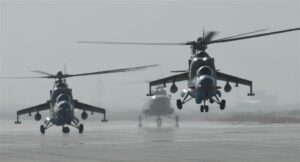
Truck-mounted AN/TPQ-53 radar.
Just weeks after winning $1.6 billion to build more Q-53 artillery-tracking radars, Lockheed Martin is pushing the Q-53 hard as a triple-threat solution to drones and manned aircraft as well. AN/TPQ-53s, to use their full name, have already been tested successfully against drones, helping Lockheed win a $28 million contract to upgrade their software to do the counter-drone mission. Now the company says another software upgrade should make them capable of so-called Short-Range Air Defense (SHORAD) as well.
With 100 more of the radars built and 70 more on the way, getting triple duty out of something already in the Army budget is attractive. With adversaries ranging from Daesh (aka ISIS) to the Russians making ever greater use of drones, while resurgent Russian aggression revives Cold War threats of massed artillery and airstrikes, counter-battery, counter-drone, and anti-aircraft is a trinity of largely neglected capabilities that Army units need. (For the record, Lockheed Martin diplomatically didn’t name specific threats: That’s all us). And with the Army looking at dispersing its forces in Distributed Operations to evade precision strikes, an ever-large number of ever-smaller units will need to be equipped to defend themselves.

Russian-made Hind attack helicopters in Afghan service. The Army is increasingly concerned about the revival of such Cold War air threats.
Of course, there’s a tradeoff, Lockheed Q-53 director Rick Herodes acknowledged. The more varied are the types of targets a radar tries to detect at the same time, the worse the job it’ll do on any particular one.
“Radar performance is really a function of time-energy management — that is, how much energy for how long can you put on a particular target,” Herodes told reporters this morning. “So when you want to use a radar to look for two different types of things that have different characteristics, you don’t have all the time and energy, that you could dedicate to a singular type of target.”
A reconnaissance drone circling slowly at low altitude, for instance, has a very different radar profile than an artillery rocket streaking towards US forces on a perfect ballistic arc, and both are different again from a terrain-hugging helicopter gunship. A radar optimized to detect one with do less well against the others.
The advantage of modern electronically-scanned array radars like the Q-53, however, is that you don’t have to rebuild the hardware to change what targets they’re optimized against: You can just change the software. So Lockheed is offering multiple modes for commanders to choose from to meet the needs of the moment.
The original Q-53 detects incoming artillery shells and rockets. Lockheed’s $28 million contract is to create a dual-mission mode, in which Q-53s simultaneously watch for incoming artillery and for enemy drones. Now Lockheed is proposing to create a SHORAD-only mode, Herodes said, “a third blade in the Swiss Army knife.” In this scheme, Q-53 operators would be able to switch back and forth between the original counter-artillery-only mode, the dual-mission counter-artillery and counter-drone mode, or a single-mission air defense mode.
That said, “we’ll make it do whatever the Army wants to do,” Herodes said. “It has the potential to do all three at once or do them independently.” If you focus all the radar’s time and energy on one type of target, you maximize its performance at the risk of being blindsided by something you weren’t looking for; if you watch for everything at once, you won’t see any particular thing as clearly.
“The time and energy is infinitely variable,” Herodes said. With the right software, you could tweak these tradeoffs in any combination, like using a color wheel to adjust proportions of red, blue, and green.
In the long run, radars might be able to do even more missions. Lockheed is one of the companies researching how to reconfigure AESA to transmit and receive communications, Herodes said. There is also research into using AESA offensively to jam enemy radars and communications. The more functions you pile onto one radar, the more you risk spreading it too thin — but commanders would like to have the option.
In a ‘world first,’ DARPA project demonstrates AI dogfighting in real jet
“The potential for machine learning in aviation, whether military or civil, is enormous,” said Air Force Col. James Valpiani. “And these fundamental questions of how do we do it, how do we do it safely, how do we train them, are the questions that we are trying to get after.”


























